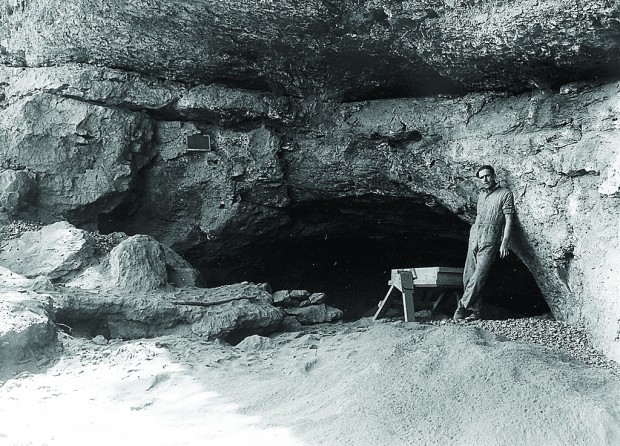Between 1925 and 1936, Jackson County, Iowa, residents Paul Sagers and his brother Fay spent countless hours combing the bluffs and countryside hunting for the pottery, stone tools and animal bones left by the prehistoric people who lived there long before them.

But the bulk of the items are at the University of Iowa, where they have been catalogued by the Office of the State Archaeologist and are stored in such a way that they are preserved and available to researchers, but not usually out where people can see them.
An opportunity to see some of the collection comes Saturday, Oct. 8, when it will be showcased in an open house.
Five new display panels related to the collection - with photos, drawings and maps of excavations - also will be unveiled, and State Archaeologist John Doershuk will speak at 1:30 p.m. about Sagers' contributions to Iowa archaeology.
Among the places where Sagers found artifacts are what's called rock shelters, or alcove-like openings, in bluffs. He excavated 13 of these in Jackson and Jones counties, including the Levsen Rock Shelter, where he found a type of pottery that has henceforth been called "Levsen" pottery by archaeologists when they find it in other places.
That's because Sagers' finds were among the first and best of that type, so the Levsen shelter became "a marker, a point of reference," Doershuk said. To have one's excavation site referred to by other archaeologists as a "type site" is significant, he explained.
Another factor that makes the Sagers collection special is the unusually well-preserved animal bones, including those that are the remains of animals such as deer, elk, turkey and bear that people caught and ate, as well as the tools they fashioned from the bones, Doershuk said.
At many prehistoric sites, animal bones are subject to deterioration, but they lasted very well in the Jackson County rock shelters, he said.
Sagers' background
Paul and Fay became interested in archaeology as teens after their father introduced them to Frank Ellis, who had a large collection of artifacts from sites near Maquoketa. Ellis introduced Paul to Charles R. Keyes, the director of the Iowa Archaeological Survey, in 1925.
That was particularly fortuitous because Keyes was able to guide Sagers on proper excavation techniques as well as the importance of documentation and maps of where the objects came from, Doershuk said. That is very important in archaeology because "context is everything," he added.
Often, people will find, say, a stone tool that is very beautiful, but without knowing the exact location where it was found, archaeologists cannot study the area and piece together a story of the people who made it.
In 1934, Paul Sagers opened an exhibit of his collection at his parents' home. As the collection grew, he decided to build a museum.
Working with his son Lane, Sagers quarried limestone and constructed the museum building between 1945 and 1949. The Sagers Museum opened in 1951 and was operated by Paul and his wife Nettie until Paul's death in 1982. Nettie continued to operate the museum with the help of her family until 1988; she died in 1990.
The Sagers collection was then given to the Iowa Department of Natural Resources, and the Office of the State Archaeologist serves as the repository, Doershuk said.
The artifacts are from the Woodland-era cultures who occupied Iowa from around 800 B.C. to 1200 A.D. Eventually, these people evolved into the American Indians that European settlers encountered when they came to this area, he said.
Sagers' daughter, JoAnn Caven of Maquoketa, describes her dad as a jack of all trades. He farmed, worked in a sawmill and a factory, and was also a carpenter, taxidermist and inventor. That's in addition to being a fine amateur archaeologist.
Author: Alma Gaul | Source: Quad-City Times [October 04, 2011]